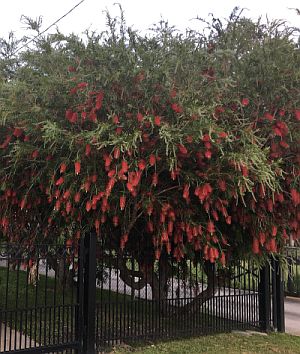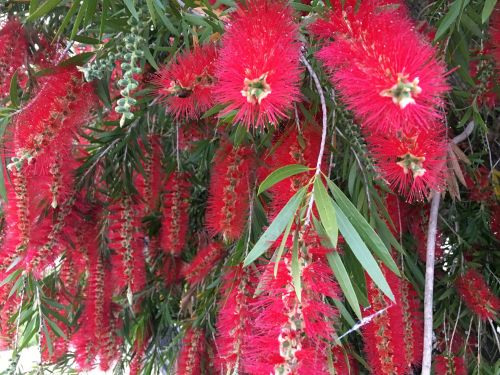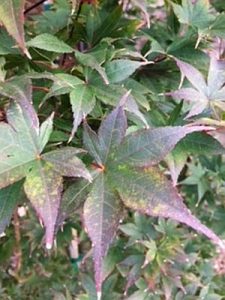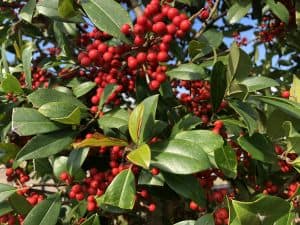(Image above: Bottlebrush blooms”)
Now is the Time to Plant Trees
Now is the time to plant trees for the New Orleans. November through February is best in our area. This will allow the roots of your new tree to become established before the hot, dry summer season. Container grown trees can be planted at any time.
Monitor your tree(s) for disease, insects and broken or dead limbs. It takes about 12 months for a newly planted tree to become established for every inch of trunk caliper. A 3-inch caliper tree will take about three years to become established. Regular watering is important during this critical phase. New trees need about 1 inch of water each week for about two years when rainfall is low. Do not drown the roots by overwatering; they need air as well as water to grow.

(Image, left: Bottlebrush, Callistemon rigidus)
Don’t add fertilizer at planting. Sprinkle a balanced fertilizer (one that contains nitrogen, phosphorus, potassium and micronutrients) over your planting area the next spring, and then again two times during the growing season. It is recommended to follow the fertilizer’s label as to the amount to apply. Too much fertilizer can injure the tree. Mulch will provide a natural source of nutrients to the tree. Maintain a 3- to 4-inch mulch layer around trees keeping the mulch away from the base of the trunk to avoid rotting the bark.
Do not prune trees at the time of planting unless it is to remove, 1. Dead branches, 2. Diseased or damaged branches, 3. Crossed or rubbing branches. Always sterilize your tools to avoid the spread of disease. Do this before you start, when moving from tree to tree and when the job is complete. (See pruning guide for more information)
Trees provide energy conservation, increase property value and help with water conservation. They may provide wild-life habitat and of course are esthetically pleasing to the landscape.
Plan where you want to plant your tree. Consider the mature size of the tree, light and water requirements. Never plant trees too close to buildings or power lines. Some trees provide fragrant flowers and color. Others may be messy, dropping leaves and trash from spent blooms. So do your research. Consider planting Natives. See Native Tree Growing Guide for Louisiana, also contact your county agent for other lists of trees for special places and circumstances.
(Images, right: [top] Sasanqua camellia ‘Yuletide’; [center] Japanese Maple; [bottom] Savannah Holly)
Tree Size Terms
- Small trees – 15 to 25 feet
- Medium trees – 30 to 55 feet
- Large trees – over 60 feet
Great Small Trees: (Dan Gill, LSU AgCenter Consumer Horticulturist (retired). I have added a few of my favorite shrubs that can be grown as small trees to the list. This list is by no means complete and is only recommendations.
- Parsley Hawthorn, Crataegus marshallii
- Redbud, Cercis canadensis Forest Pansy Redbud, Cercis canadensis ‘Forest Pansy’
- Taiwan Cherry, Prunus campanulata
- Star Magnolia, Magnolia stellata
- Oriental Magnolia/Japanese Magnolia, Magnolia x soulangeana
- American Fringe Tree, Chionanthus virginicus
- Chinese Fringe Tree, Chionanthus retusus
- Evergreen Dogwood, Cornus angustata
- Peggy Clark Japanese Apricot, Prunus mume ‘Peggy Clark’
- Persian Ironwood, Parrotia persica
- Sasanqua, Camellia sasanqua
- Silver Bell, Halesia diptera
- Japanese Maple, Acer palmatum
- Crape Myrtle, Lagerstroemia indica, L indica x fauriei
- Cherry Laurel, Prunus caroliniana
- Chinese Pistachio, Pistacia chinensis
- Deciduous Holly, Ilex decidua
- Dahoon Holly, Ilex cassine
- Yaupon Holly – Ilex vomitoria; standard and weeping
- Deciduous Holly – Ilex verticillata
- Savannah holly, Ilex opaca x Ilex cassine = Ilex x attenuata
- Chalk Bark Maple, Acer leucoderma
- Trident Maple, Acer buergeriaum
- Southern Sugar Maple, Acer barbatum
- Cherry Laurel, Prunus caroliniana
- Wax Myrtle, Morella cerifera (previously Myrica cerifera)
- Sweet Olive, Osmanthus fragrans
- Vitex, Chaste Tree, Vitex agnus castus
- Banana Shrub, Magnolia figo formally Michela figo
- Bottlebrush, Callistemon rigidus
Visit lsuagcenter.com for more information on trees:
Native Tree Growing Guide for more detailed information

By Karen Blackburn




